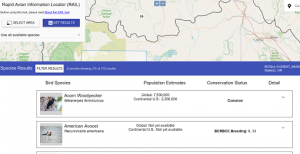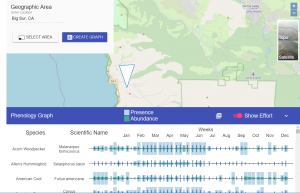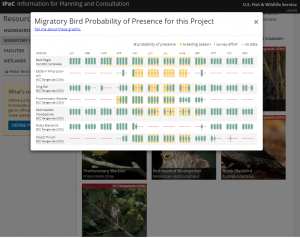Important Information About Data Limitations and Use
It is the responsibility of the user to make sure any data or data summaries obtained via the AKN are used appropriately and that users properly acknowledging any and all sources of data, and any limitations of those data. To learn more about the data sources feeding into the various tools, please read About the Data Sources and Types contributing to AKN Tools. Data limitations associated with data summaries provided by tools like the Phenology Tool will be found in the “About” sections on the pages for those individual tools. Please examine this information closely before using the data or tool summaries in any analysis, research projects, or other products.
EXPLORE AND ANALYZE DATA
Broad-use Cross-Node Interactive Data Analysis, Visualization and Summary Tools
These are visualization and analysis tools that use data gathered across all nodes of the AKN.
Rapid Avian Information Locator (RAIL) Tool
 New! The RAIL Tool allows the user to query a specific geographic location and return a list of birds that are known to occur in that area based on the underlying data in the AKN, along with a wealth of information about those birds including their conservation status and population size at various scales. The tool imports information from the Partners in Flight (PIF) Avian Conservation Assessment Database (ACAD) and the PIF Population Estimates Database, and also incorporates other supplemental information (e.g. conservation status on multiple scales, clutch size, bird weight, size and diet, primary habitat, photos and range maps) that might be helpful for permitting and making conservation and management decisions for birds.
New! The RAIL Tool allows the user to query a specific geographic location and return a list of birds that are known to occur in that area based on the underlying data in the AKN, along with a wealth of information about those birds including their conservation status and population size at various scales. The tool imports information from the Partners in Flight (PIF) Avian Conservation Assessment Database (ACAD) and the PIF Population Estimates Database, and also incorporates other supplemental information (e.g. conservation status on multiple scales, clutch size, bird weight, size and diet, primary habitat, photos and range maps) that might be helpful for permitting and making conservation and management decisions for birds.
The Phenology Tool allows the user to view abundance and relative probability of presence summaries throughout the year for birds in a particular region or project area. For a short web tutorial on this tool, please visit the Phenology Tool video tutorial.
The Observations Map allows the user to visualize, query, and investigate data at surveyed locations by species, survey location or area of interest. It also allows users to view individual datasets separately, and download reports of results. For a short web tutorial on this tool, please visit the Observations Map Tool video tutorial.
The IPaC Tool allows users to view their project or activity’s potential impacts on U.S. Fish & Wildlife Service’s Trust Resources, including endangered and threatened species and migratory bird species of concern. Migratory bird lists in IPaC and associated seasonal probability of presence graphs are generated using best available data on known bird occurrence via data points in the AKN. For a short web tutorial on this tool, please visit the IPaC Tool video tutorial.
Data Owner Analysis Tool
This tools requires an AKN account and login and is only available for use by those that are storing their data directly in the AKN.
The Analyst application within the AKN enables users to retrieve and analyze data they own, or that has been shared with them by a project owner. This application is designed for people with some knowledge about the data, offers password-protected access, and is intended to help develop project reports. For a short web tutorial on this tool, please visit the Analyst Tool video tutorial.
Node-specific AKN Data Exploration Tools and Products
There are many node-specific data exploration tools within the AKN. There are also many data products that are not directly working with the underlying AKN data, but may have used the AKN data along with other data resources in developing products that help answer questions and inform decisions. To see a full list of the data products and tools available within each AKN node, and links directly to those tools and products, please see the AKN Site Map.
Other Tools and Products Outside of AKN
To view a list of other tools and products that might be helpful for answering bird conservation questions and looking at species patterns and trends, please visit Other Recommended Resources.




